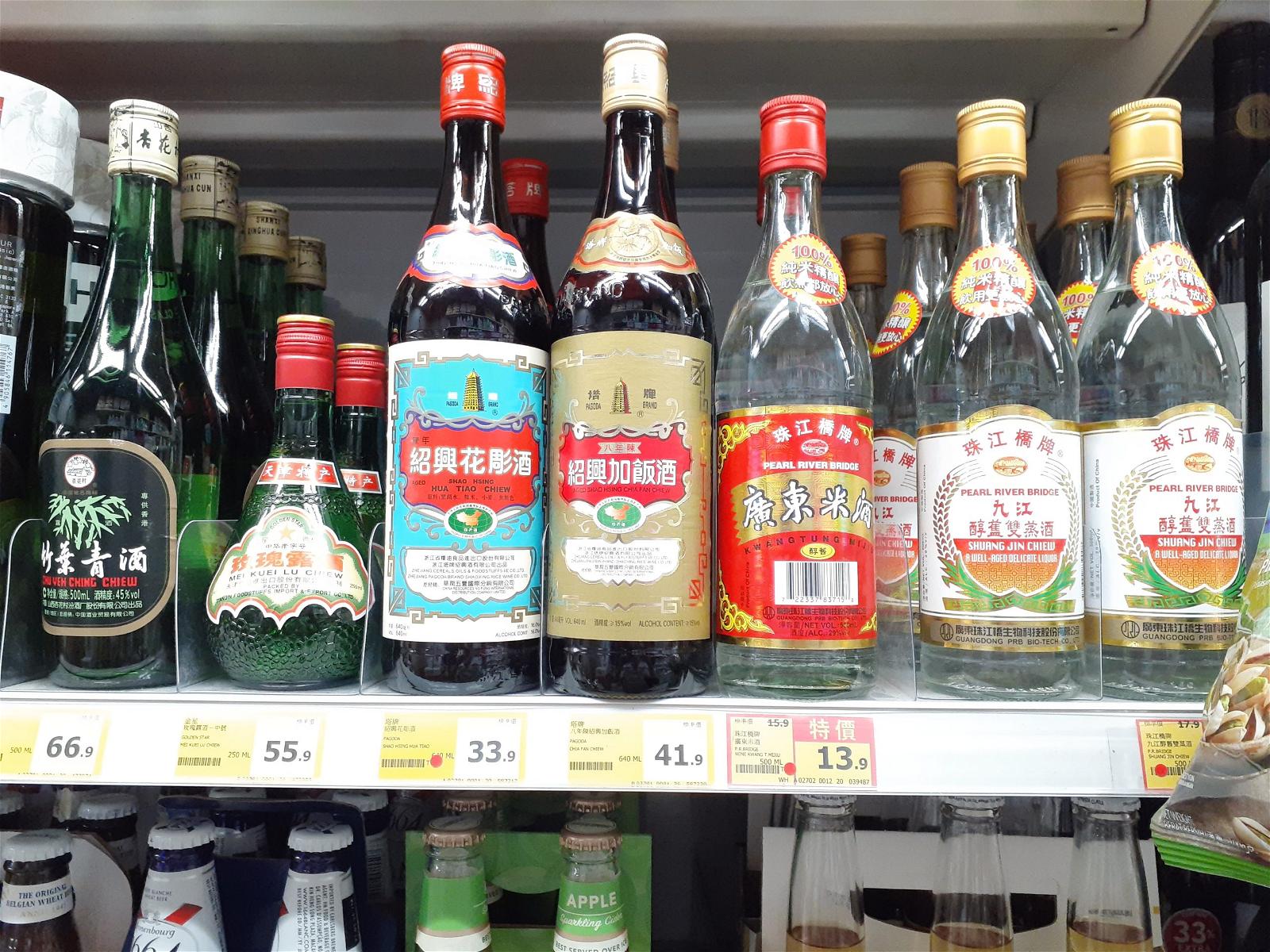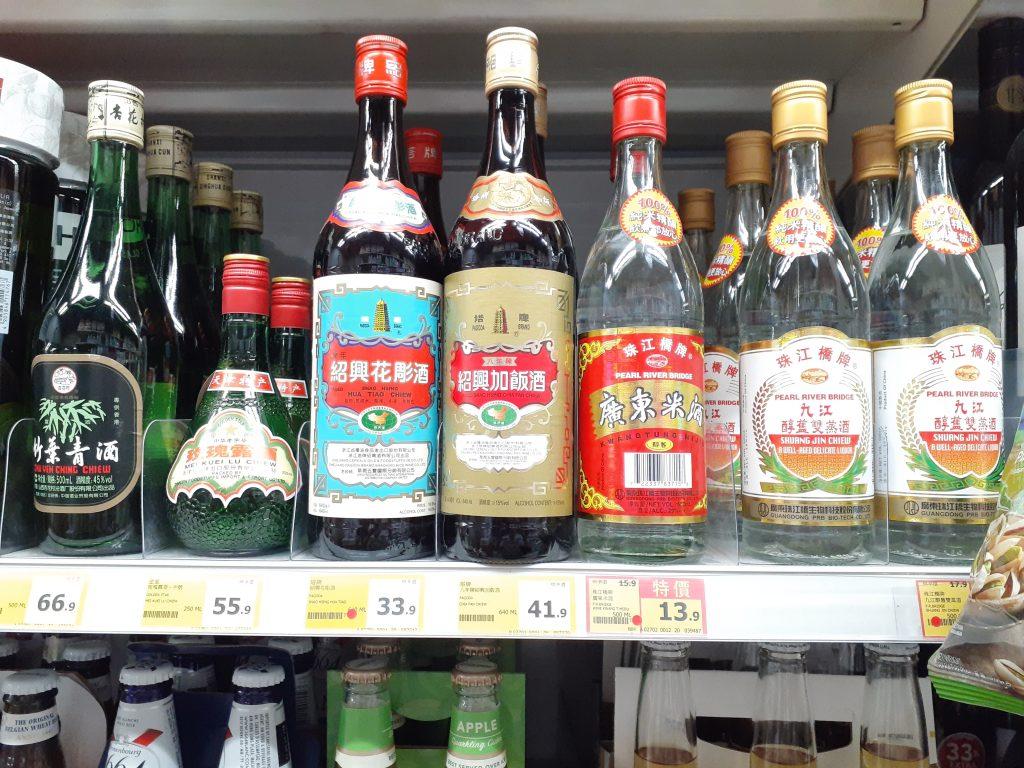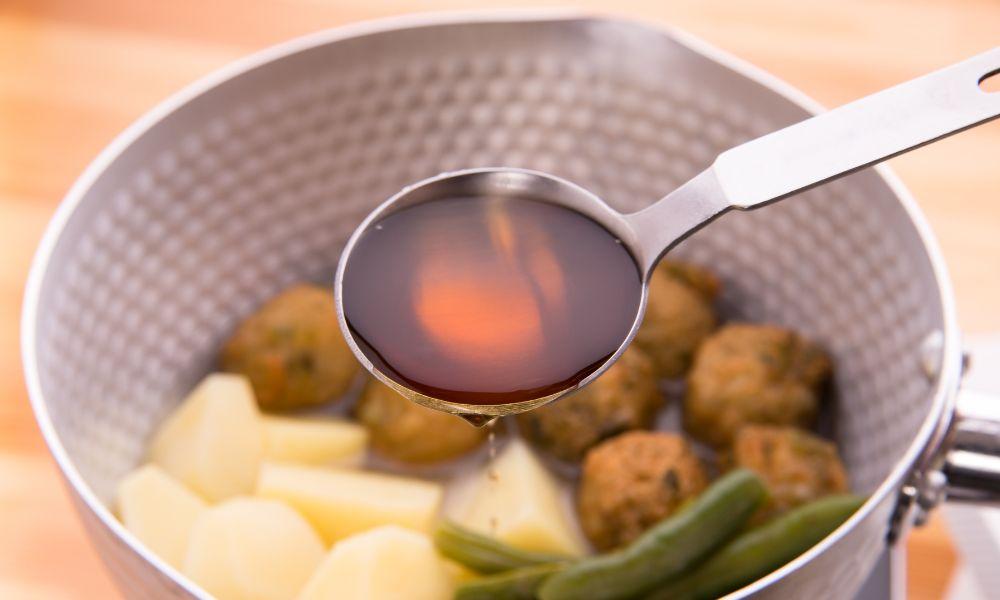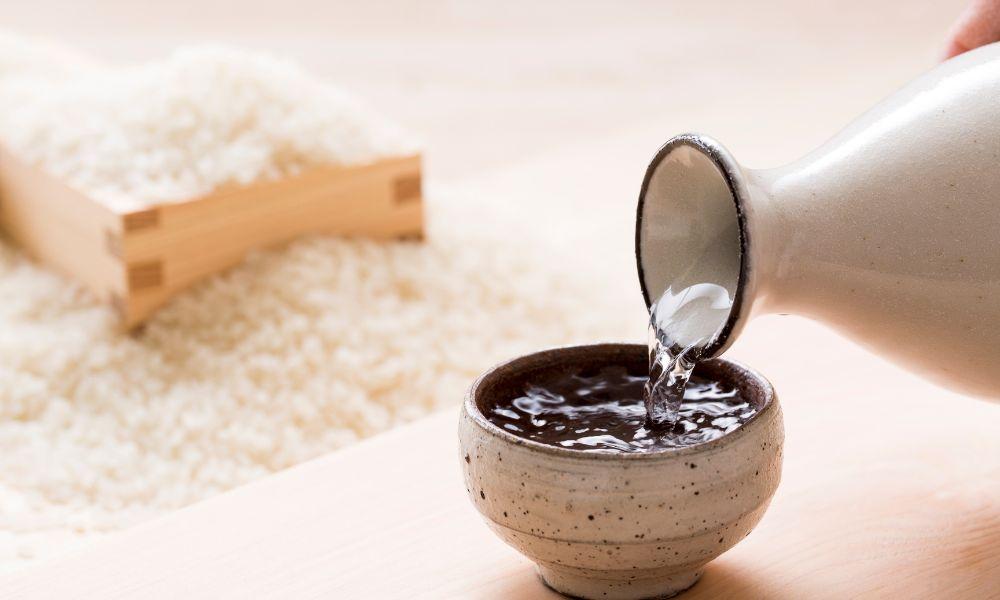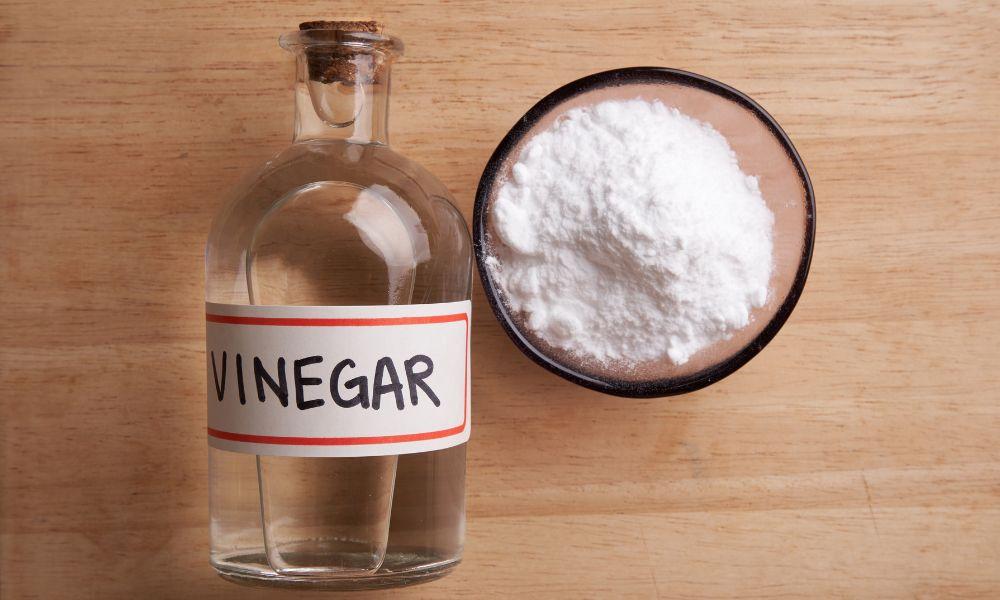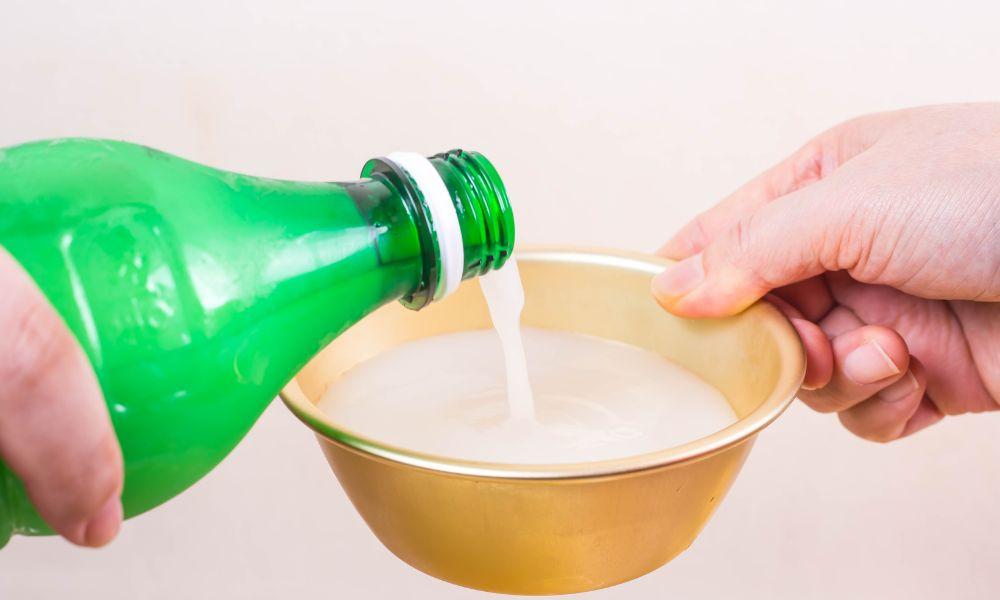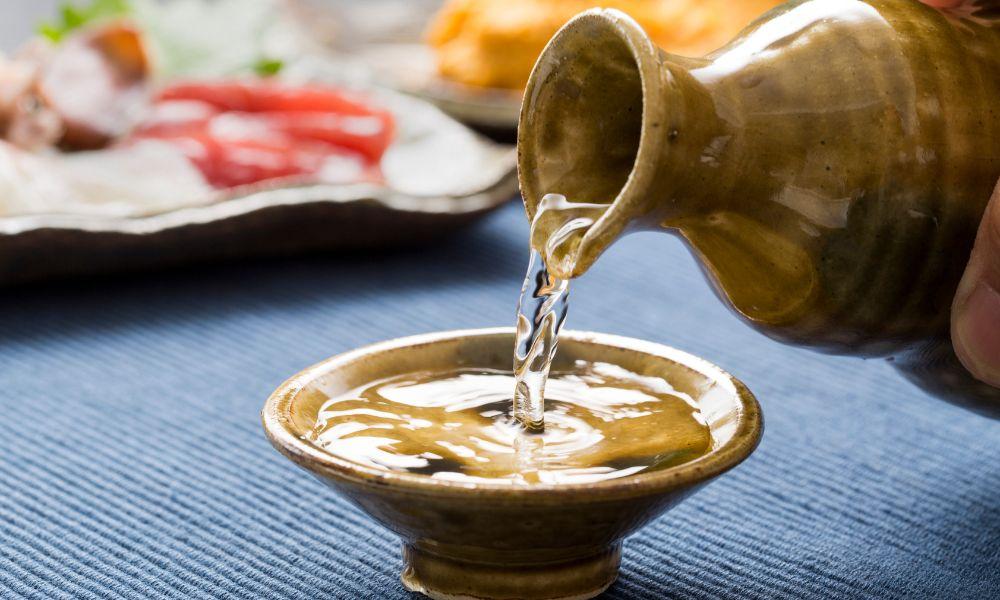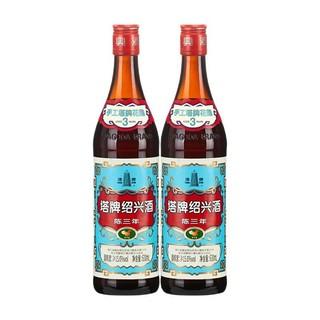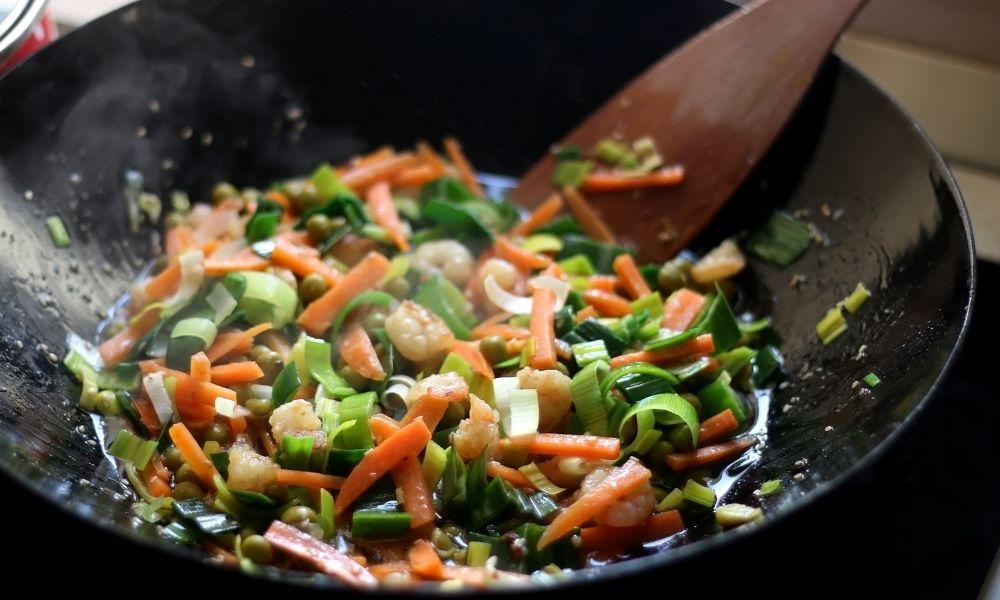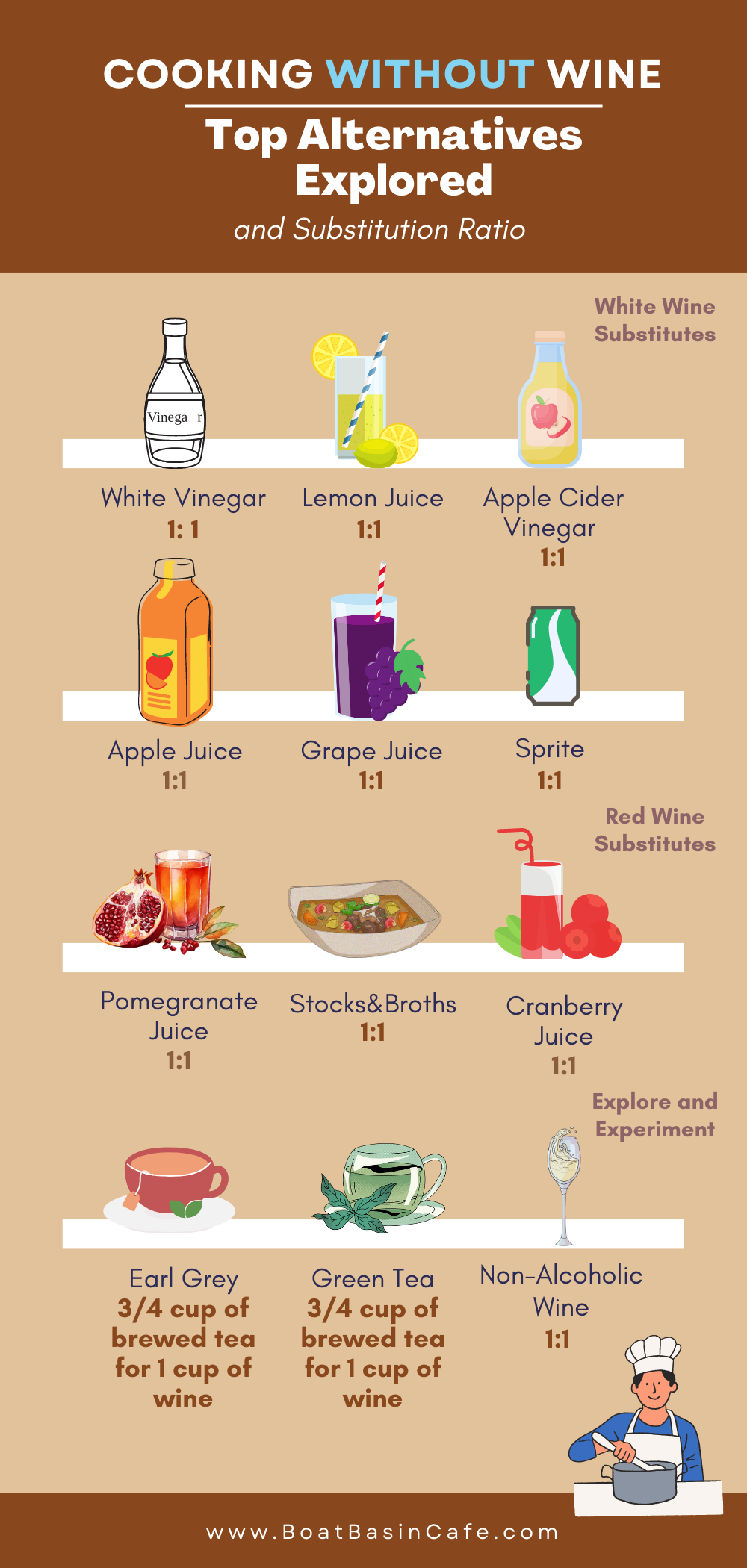Picture this: you’re almost done cooking a fancy meal. However, there’s one big problem. You don’t have a major ingredient- red wine!
What can you do?
Perhaps. Keep cooking without it?
There’s something else you can do. You can use several red wine alternatives!
We’ll tell you all about the different alternatives for red wine, what recipes they are best for, the recipes they shouldn’t be used in and all the products we recommend. Keep scrolling and we’ll answer all your questions!
Red Wine in Recipes
People use wine in cooking for several reasons- it is used in marinades to tenderize or add flavor. Next, people use it as a cooking liquid to stew or simmer other ingredients in. Finally, it is used to flavor finished dishes, both savory and sweet.
Check out the details below!
In Sauces, Marinades & as a Cooking Liquid:
Red wine is best used when added to slow cooking recipes like rich tomato sauces, beef or lamb stews, to braise duck and other dark meat.
The wine can even be added to rice-based dishes like risotto to add richness and depth to an otherwise simple meal. Many recipes call for reducing red and using them to glaze meat, vegetables, and tofu.
When making these slow-cooking dishes, add the wine at the beginning of the cooking process. For pan sauces, add it after removing the meat from the pan and use it to deglaze the pan.
In marinades, the wine is usually added to the other spices and marinating ingredients to soften and flavor the meat over a few hours.
Red wine is also used in various pan sauces or added to soups and braising liquids. Dry red wines like Cabernet, Pinot Noir, and Merlot are great for adding flavor to dishes.
In Desserts:
Wondering about desserts?
Red wines with fruity tones are often used to poach fruits and added to sorbets. They are also used in puddings, truffles, custards, and even cake batter.
Red wine pairs wonderfully well with dark chocolate and enhances the taste of fondue, glazes, and ganache. Also, the wine is often used to reduce sauces that are often drizzled over cakes, puddings, and crème brûlée.
In many of these sweet courses, the alcohol in the red wine evaporates during the cooking or baking process. Instead, you’re left with the rich, decadent color and flavor of the wine.
Considerations When Choosing a Substitute
- Flavor: The substitute should have a similar flavor profile to red wine, with some acidity, tannins, and fruitiness.
- Color: Red wine is, of course, red, so a substitute should also have a similar color. This is particularly important for visual appeal in dishes like stews and braises.
- Acidity: Red wine has some acidity, which is important for balancing flavors in a dish. A substitute should also have some acidity to achieve a similar effect.
- Alcohol content: If you’re substituting for health or personal reasons, you’ll want to choose a substitute with little or no alcohol.
Top 10 Best Substitutes for Red Wine in Cooking
Now you know why red wine is used in cooking and baking, so let’s jump right into the matter! Here are 10 great alternatives to red wine you can substitute in your recipes.
01. Red Grape Juice
[amazon box=”B005UO824C”]
Red grape juice is an almost perfect substitute for red wine because they look and taste very similar. Unsweetened red grape juice has a tart and sour taste, not unlike wine.
However, even the unsweetened version maybe a little too sweet, so add a dash of vinegar to the juice. This will give it some of that aged depth that you get with wine.
If you want to substitute grape juice for red wine, it is best used when deglazing pans when roasting meat or added to rich and hearty soups and stews. Just replace the wine with an equal amount of grape juice and a spoon of vinegar.
If you need a red wine alternative for your dessert dish, red grape juice is a classic choice. Thanks to their similar flavor, you can easily replace red wine with grape juice and your dessert will taste the same.
Best for:
The acidity of grape juice makes it excellent for deglazing cast-iron pans. After roasting meat or sautéing vegetables, the caramelized bits get stuck to the pan. These bits are full of flavor and add dimension to your dish.
To clean your pan and extract this flavor, you need some kind of acidic liquid to deglaze the pan. Wine is often used to do this, but red grape juice will also get the job done.
The same logic applies to marinades. The acid in wine tenderizes the meat which is why a splash of wine is added to the marinade. Simply swap out the red wine for an equal amount of juice.
The tart flavor also makes red grape juice a great addition to thick, rich stews. The acidity complements the aromatics and other ingredients in many soups and stews.
You can add even sugar to the juice and reduce it to make decadent glazes and sauces for dessert. It is also a good option if you need a non-alcoholic liquid to poach fruits in.
Not Recommended for:
On the other hand, if you’re making pasta sauce, it would be best to avoid red grape juice. The juice is too sweet for marinara or bolognese. Furthermore, the overly fruity flavor of the juice would not go well with delicate, tomato-based sauces.
Product Recommendation:
Red grape juice can be found in many grocery and convenience stores. We prefer Life Tree Unsweetened Grape Juice Concentrate because of its high quality and strong, concentrated flavor.
02. Cranberry Juice
[amazon box=”B083M26PJY”]
Like red grape juice, cranberry juice is another good alternative to red wine. It tastes and looks very much like red wine, especially the unsweetened version. However, to get a flavor profile that is almost identical to red wine, add a tablespoon or two of vinegar to the juice.
Particularly adventurous cooks often use equal amounts of grape juice and cranberry juice with a little apple cider vinegar to replicate the exact taste of dry red wine.
That’s not all. Cranberry juice has several health benefits.
It is rich in antioxidants which are crucial for keeping our cells healthy. They also help prevent cancer. Moreover, there is evidence that it can prevent and treat the occurrence of frequent urinary tract infections.
Best for:
Cranberry juice has the perfect tartness and flavor that makes it perfect to use instead of red wine in marinades, to deglaze pans when roasting dark meat, in soups and stews.
Unsweetened cranberry juice is also great for making simple but flavorful pan sauces that go wonderfully well with roasted meat.
If you need a red wine substitute for dessert, cranberry juice will work here as well. It is often used to make glazes for cakes and buns, as well as sauces for puddings and custards.
Poaching pears in cranberry juice infused with cinnamon and star anise will make a simple, yet delicious dessert that is guaranteed to be a crowd-pleaser.
For an after-meal drink, cranberry juice is a great choice. It is used as a base in many mocktail recipes. It even makes a refreshing drink when simply poured over ice and garnished with mint.
Not Recommended for:
Cranberry juice has a bright and fruity flavor; it also has a very strong and distinct taste. This means it will interfere with the flavor of pasta sauces. As a result, it is better if you don’t use large amounts in tomato-based recipes.
Product Recommendation:
Organic cranberry juice is available in many grocery stores, farmer’s markets and even drug stores. Our cranberry juice of choice is Unsweetened Pure Cranberry Juice as it is fresh and has no added sugar.
03. Vinegar
[amazon box=”B08137425D”]
[amazon box=”B07RRL75JZ”]
Vinegar is an excellent substitute for red wine because of its acidity or sourness. The acidity helps tenderize or soften meat.
Red wine vinegar is the best option among all the other different kinds of vinegar because the flavor profile and color are similar to that of red wine. This is because red wine vinegar is made by completely fermenting red wine.
However, apple cider vinegar and even regular rice vinegar is a good substitute for red wine as well. Make sure you dilute the vinegar with stock or juice.
Best for:
Vinegar’s acidity and sharp taste make it a common ingredient when deglazing pans and as an addition to marinades. If your recipe needs just a spoon or two of red wine for deglazing or in a marinade, you can replace it with an equal amount of vinegar.
On the other hand, if the recipe calls for more than a quarter cup of red wine, substituting it for an equal portion of vinegar will result in an overly sour dish.
Soups, stews, and slow-cooking pasta sauces often need up to half a cup of wine. In that case, substitute it with a 1:1 ratio of beef or chicken stock and add two tablespoons of vinegar.
Not Recommended for:
Red wine has notes of sweetness, which vinegar does not. As a result, you can’t replace red wine with vinegar in dessert dishes. Instead, use grape, cranberry, pomegranate or cherry juice as a substitute for red wine when making dessert.
If you have special dietary restrictions and are unable to consume fermented or acidic foods, it is recommended to avoid vinegar altogether as a substitute.
Product Recommendation:
You can find vinegar almost everywhere, especially in your local grocery store. Our favorites are Red Wine Vinegar, and Apple Cider Vinegar because they guarantee flavor and quality.
04. Tomato Juice
[amazon box=”B07Q83V425″]
Tomato juice is quite similar to vinegar when it comes to the flavor profile. It is very acidic and somewhat pungent.
Also, the rich red color gives it a similar appearance to red wine. This is what makes tomato juice a wonderful alternative to red wine.
Because of its complex flavor, tomato juice is often added to marinades and sauces to enhance the taste of the dishes. Based on the flavor you want in your dish; tomato juice can be used instead of red wine at a 1:1 ratio.
Unlike other fruit juices, tomato juice is pretty bitter on its own. If you think tomato juice will affect the taste of your dish, add a little grape or apple juice to sweeten it up a little.
Tomato juice is a very healthy alternative to wine because tomato is rich in a compound known as lycopene. Lycopene is an antioxidant that is known to reduce the risk of cancer. It is also full of Vitamin C and Vitamin A.
Best for:
This juice is excellent for tomato-based dishes. Beef stew, hearty soups, and marinades for kabobs are just a few dishes where you can replace red wine for tomato juice.
Other dishes include slow cooking sauces that need to be simmered for an hour or more like marinara, ragu or bolognese.
When substituting tomato juice for red wine, keep tasting your dish to make sure the taste isn’t overly different.
Not Recommended for:
Since it’s extremely sour and somewhat bitter, it goes without saying that you shouldn’t use tomato juice in desserts.
Pan sauces tend to have delicate, light flavors. Tomato juice is too sour and strong to use in these kinds of quick sauces.
Product Recommendation:
Tomato juice is easy to find in almost all grocery stores. If you can’t find it in your local store, try an organic store instead. Sacramento Tomato Juice is our juice of choice thanks to its freshness and tart flavor.
05. Chicken or Beef Broth/Stock
[amazon box=”B07RV3JM2S”]
[amazon box=”B073XW1RTL”]
If you need a quick and easy replacement for red wine in your cooking, beef broth is an excellent choice. Beef broth has a rich and dark color. It is also very flavorful, so you can use it as an alternative to red wine without worrying about your food turning out bland.
It is made by simmering animal bones and meat in cold water. Vegetable scraps, spices, and aromatics are also added to increase the flavor of the broth.
However, red wine is acidic. Beef or chicken broth isn’t.
While you can add an equal amount of broth to a recipe that calls for red wine, it is best if you add a teaspoon or two of vinegar. The vinegar will add tartness and help tenderize the meat in stews or sauces.
Best for:
Broth is a great ingredient for deglazing pans after frying or roasting. It also adds incredible flavor to soups, stews, and sauces. You can also use chicken or vegetable stock instead of beef broth. However, it won’t have the same flavor or rich color as beef broth.
Broth will enhance the flavor of sauces and soups. A splash of stock can also deglaze cast iron pans and this is why people often add it to make pan sauces.
Not Recommended for:
As broth is flavorful but mild, it isn’t a good substitute to use in marinades. Marinades contain ingredients that are strongly flavored, acidic or spicy.
Since broth/stock is savory and very salty, you can’t use it to substitute red wine in desserts. We also recommend avoiding broth if you are on a low sodium diet.
Products Recommendation:
If you like bone broth, Zoup!Beef Bone Broth has amazing flavor and depth. The Flavor Chef Chicken Bone Broth is a great option for people avoiding beef and beef products.
06. Pomegranate Juice
[amazon box=”B07PWJZHX9″]
Pomegranate juice is tart and flavorful, just like cranberry juice. The complex flavor profile and deep color also makes it a good substitute for red wine in many recipes. If you want to use it as a red wine alternative, make sure you get the unsweetened version.
To match the acidity of the wine, add a tablespoon of apple cider vinegar to the juice. If you want to tone down the fruitiness, you can even dilute some of the juice with stock or broth.
There’s more.
Pomegranate juice is great for you and is chock full of antioxidants. It is also known to reduce the risk of heart disease and diabetes.
Best for:
The bright, fruity notes make it an excellent ingredient for salad dressing. You can even reduce the juice and add herbs and seasoning to make a glaze for roasted vegetables, beef or even turkey.
If the amount of wine needed is small, you can substitute it with an equal amount of pomegranate juice in stews and to deglaze the fond from searing or roasting meat.
Just like cranberry and grape juice, pomegranate juice is a great option if you want to make an alcohol-free dessert. Whether you want to poach fruits, make a sauce for waffles or a glaze for pastries, pomegranate juice will add a rich flavor to almost all desserts.
If you want something to drink, you can add different flavored syrups to pomegranate juice and pour it over ice. Moreover, pomegranate juice is also a good base for mocktails and other fancy drinks. A splash of the juice also improves the flavor of iced teas and other herbal beverages.
Not Recommended for:
On the other hand, the bright floral notes in pomegranate juice make it unsuitable to add in light soups, pasta or pizza sauces. The fruity and floral flavors will overpower the taste of the other ingredients in these dishes.
Products Recommendation:
We love this Organic Pomegranate Juice because it tastes amazing, is full of antioxidants and is very affordable. Absolute Pomegranate Juice Concentrate is another great choice and you need to dilute it with water or stock before using it in your cooking.
07. Cherry Juice
[amazon box=”B079Z1BJLJ”]
Cherry juice is a slightly lesser-known alternative to red wine. However, this juice is just as sharp as grape or cranberry juice. It is also pleasantly sweet which makes it a milder option when compared to vinegar.
This juice has a bold color and will add vibrant hues to your dish just like red wine. For best results, use an unsweetened version.
Cherry juice with added sugar will make your meal overly sweet. Substituting cherry juice for red wine is simple- just replace the wine with an equal amount of the juice.
Cherry juice is known for its health benefits too. Cherries contain melatonin, which helps regulate sleep patterns.
Best for:
If you’re replacing red wine in a recipe that is using it for flavor, cherry juice is the perfect choice. The tart sourness of the cherries makes it a good ingredient for salad dressing.
Complex dishes like beef bourguignon and oxtail stew can use cherry juice as a proxy and it won’t dramatically change the taste of the dish.
Moreover, the juice adds dimension to meat when used in marinades or to deglaze and make pan sauces. It also adds a lot of color to roast beef and other dark meat. The addition of cherry juice can make any dish look visually appealing.
Cherry juice also makes a wonderful glaze for both sweet and savory courses. Adding a spoon of the juice to chocolate cake batter also adds a rich and fruity note to the final product.
Not Recommended for:
Since cherry juice has an extremely fruity taste, it can overpower the taste of other ingredients in your recipe. This is why you shouldn’t use this juice in pasta sauces as it will clash with the flavor of the tomatoes.
The bright flavor also makes it unsuitable to use with chicken and lean meat.
Product Recommendation:
This Tart is Smart cherry juice concentrate is extremely popular due to its full strength of flavor and because it is available in bulk.
08. Raspberry Juice
[amazon box=”B074JHKMNB”]
In many ways, raspberry juice is very similar to a grape, cherry and cranberry juice. It is tart and acidic with a dark color. It also acts very similarly to these juices when used as an alternative to red wine.
The acidity and color make it taste and look like red wine. As a result, raspberry juice is often used to make glazes and sauces and is even added to salads.
To substitute red wine with raspberry juice, simply replace it with an equal amount of raspberry juice with a teaspoon of red wine or apple vinegar.
Best for:
This juice is best used in small amounts. For example, if you just need a tablespoon or two to deglaze a pan or add to a marinade.
When simmered and reduced with other ingredients, raspberry juice makes a wonderfully flavored glaze for vegetables. A non-reduced version is also used often to make sauces for meat. The tart and fruity notes complement the flavors of grilled or roasted dark meat.
If you are making a stew or a thick pureed soup, you replace red wine with raspberry juice. This is because the wine is added for a bit of flavor and color.
Raspberry juice is wonderful when used in dessert dishes. If you need to replace red wine in cake batter or pie/tart filling, just substitute it with an equal amount of raspberry juice.
If you want to make child-friendly drinks, raspberry juice is also a good alternative to use in mocktails and other alcohol-free drinks.
Not Recommended for:
Just like cranberry, pomegranate and grape juices, raspberry juice doesn’t work well with slow-cooking pasta sauces. Its distinct taste will overshadow the tomato and aromatics in the sauce and completely alter the taste of your dish.
Product Recommendation:
You can find raspberry juice at almost any grocery store. However, we love this Flavors Raspberry Concentrate because it is unsweetened and lasts for a very long time. It tastes amazing and has an intense flavor you can use to make drinks as well!
09. Apple Juice
[amazon box=”B07NW261XV”]
Let’s face it. How often do we have pomegranate or raspberry juice in our kitchens? Most of the time we don’t.
On the other hand, most people do have apple juice at home. If you’re in a rush and can’t run to the store for our other substitutes, you can easily use apple juice as a substitute for red wine.
Unsweetened apple juice has a mild and mellow flavor that won’t overpower your dishes. It also has a pleasant tangy tartness that will give your dish a flavor boost.
Since apple juice isn’t very sour, add a spoon of vinegar when using it instead of red wine. Just replace the wine with an equal amount of apple juice.
Bear in mind that apple juice won’t add much color to the food as it is very light.
Best for:
The tartness makes apple juice a great ingredient for salad dressing. The light flavor and color also make it a good choice to use when roasting or baking chicken or fish.
Since apple juice has a very mild flavor, it is best used when the recipe needs a very small amount of wine. This means it is best used for deglazing and in marinades.
You can also add it in small amounts to cake batters, fritters, or in apple pie fillings. Apple juice is also added to a number of iced beverages. For instance, you can use it to make these delicious alcohol-free sangrias!
Not Recommended for:
Apple juice has a very subdued taste compared to grape or cranberry juice. This is why apple juice isn’t generally used in pan sauces. Even with the added vinegar, the juice may be too sweet for these sauces.
The sweetness is also why apple juice isn’t used in pasta or pizza sauces. Furthermore, the juice might lighten the color of the sauce.
Product Recommendation:
Apple juice is available everywhere, your local grocer, any grocery chain, even your farmer’s market. But if you ask us, we prefer Red Jacket Fuji Apple Juice. This juice is cold-pressed and rich in Vitamin C.
10. Canned Mushroom Liquid
[amazon box=”B07V2VKVYF”]
This might sound a little odd but bear with us. The liquid that canned mushrooms are stored in is salty. Over time, it absorbs some of the flavors from the mushrooms. This gives the liquid a salty, umami taste.
This complex flavor is why the liquid is often used to replace red wine in many recipes. Also, almost everyone has a can of mushrooms in their pantry, so it is a very convenient alternative to red wine.
Since the liquid has a very savory flavor you can add a little grape of apple juice to sweeten it up.
This works well, especially if your recipe needs a large amount of wine.
For instance, if your recipe calls for a whole cup of red wine, use half a cup of liquid from the canned mushrooms and half a cup of the juice of your choice.
Best for:
As we mentioned earlier, the liquid has a very salty, umami flavor. This means it is best used in savory dishes. You can use it for deglazing pans and when roasting any kind of meat or vegetables.
The liquid can also be used in a variety of soups and stews. If you wish, you can also use it in different sauces.
Not Recommended for:
The umami taste of the liquid makes it unsuitable to use in any kind of dessert dishes.
Another thing to remember is that the salt content of the canned liquid is very high. If you have been advised to restrict your sodium intake, we recommend avoiding this substitute. However, there are many low-sodium canned mushrooms you can use instead.
Product Recommendation:
Canned mushrooms are everywhere- you won’t have any trouble finding them in any grocery store. However, if you want to buy them in bulk, these Oriental Straw Mushrooms. They come in a pack of two 15oz cans and will last you a very long time.
How to Use Substitutes for Red Wine
When using substitutes for red wine, it’s essential to keep in mind the flavors and characteristics of each ingredient. Here are some tips on how to use substitutes for red wine in your cooking:
- Start with small amounts and taste as you go to ensure that the flavors are balanced.
- Consider the sweetness and acidity of the substitute and adjust other ingredients accordingly.
- Choose a substitute that complements the flavors of the other ingredients in your recipe.
- Experiment with different substitutes to find the one that works best for your dish.
FAQ (Frequently Asked Questions)
Below are the answers to questions we get most asked about red wine alternatives.
What Can I Substitute For Red Wine In Cooking?
The most common substitutes for red wine in cooking are tomato juice, beef stock, red grape juice, and pomegranate juice.
You can easily use any one of the above-mentioned ingredients as an alternative for red wine in various recipes. Simply swap out the alcohol for an equal amount of the substitute.
If you are using beef stock, add a tablespoon for every cup of stock you use. This is because alcohol is acidic. The acidity is absent from the stock, which is why you need to add in vinegar separately.
If you are using juice as a substitute, make sure you use an unsweetened one. Otherwise, your dish will end up much sweeter than it is supposed to be!
What Can I Use Instead Of Red Wine In Beef Stew?
Beef stew is a hearty and flavorful dish. Almost all beef stew recipes call for the addition of red wine. The wine adds dimension to the overall flavor of the meal. It also helps give the stew its rich and appetizing color.
If you want to replace the red wine with something that won’t affect the taste of your stew, your best bet is to use beef stock with red wine vinegar added to it. If you don’t have red wine vinegar, apple cider vinegar is a good option as well.
Unsweetened cranberry, cherry, and red grape juice are also excellent alternatives. They have the color the dish needs and have a sour, tart flavor profile that will work the other ingredients in beef stew.
What Can I Substitute For Red Wine In Bourguignon?
This is a little trickier, as red wine is one of the major ingredients in Bourguignon. It’s basically the foundation of the dish. However, if you’re determined to try it out without alcohol there are a few things you can do.
Substitute all the red wine for beef stock with a splash of red wine or apple cider vinegar. You can even use Balsamic vinegar if you’re feeling adventurous. Bear in mind, what you’ll end up with is beef stew and not Bourguignon.
A better substitute would be sugar-free cherry juice with just a dash of red wine/apple cider vinegar. The color and taste will be closer to authentic Bourguignon.
Can I Substitute Vinegar For Red Wine?
Vinegar is one of the more commonly known substitutes people use instead of red wine.
People generally use red wine vinegar and apple cider because they will alter the taste of your dish the least. They also have a similar color to red wine so your meal won’t look different either.
ther vinegars people substitute for red wine are white wine vinegar and plain rice vinegar. You can even use balsamic vinegar but remember it has a very strong and distinct flavor.
One thing to remember is that vinegar is much sharper and more acidic than wine. You need to dilute the vinegar, especially if the recipe calls for a lot of red wine. Just mix the vinegar with some beef, chicken or vegetable stock.
Can I Use Red Wine Vinegar Instead Of Red Wine?
Red wine vinegar is an amazing red wine substitute if you use it in rich and spicy dishes like sauces, stews, and marinades. This is because the other ingredients in the recipe will mask the strong sourness of the vinegar.
On the other, delicate dishes like roast beef need to be handled more carefully. Directly replacing red wine for red wine vinegar will result in a dish that is unpleasantly sour. Using beef stock with a little red wine vinegar is a better option.
If the recipe needs a small amount of wine (1/4 cup or less), you can safely use red wine vinegar as an alternative. Otherwise, dilute the vinegar with stock or unsweetened grape juice.
What Can I Substitute For Red Wine In Soups?
There are several substitutes for red wine when making soups and stews. The wine is usually added to either deglaze the pot after cooking the aromatics or to simply add flavor.
Tomato juice is a great option, especially if your recipe already includes plenty of tomato puree or paste in the ingredients. It won’t change the flavor or color of the soup.
Some soups require Marsala which is sweeter than tomato juice or vinegar. In that case, you should use unsweetened pomegranate juice or grape juice. These juices are naturally sweet and will add bright, fruity tones to your soup.
If you only need a spoon or two of wine for deglazing, simply swap it out for red wine or apple cider vinegar.
What Can I Substitute For Red Wine When Drinking?
Sometimes you just need to finish off a good meal with something to drink. Even if you don’t drink, you can still relax over a drink after dinner.
Low sugar cranberry or cherry juice are good substitutes for red wine. All you need to do is pour the juice over a tall glass of ice and add a splash of lemon juice. Garnish your drink with a slice of lemon and voila, you have a perfect alternative to red wine!
An Arnold Palmer is also a refreshing substitute for red wine, particularly if you need something with caffeine in it. All you have to do is add equal parts lemonade and sweet iced tea in the mug or glass of your choice.
What Can I Replace Red Wine In Spaghetti Sauce?
Some recipes ask for a splash of red wine to be added to pasta sauces, especially when making ragu, marinara or bolognese. The wine here is usually to add a little extra flavor and used as a cooking liquid.
The best substitute for red wine in spaghetti or pasta sauces is tomato juice. The juice has a sweetness and natural sugars, as well as the tartness and dark color. This makes it similar to red wine.
The tomato juice will not interfere or change the taste of your sauce. If you’re out of tomato juice, you can use tomato puree and dilute it with a little water or stock.
Can I Substitute Sherry For Red Wine?
Although many people believe sherry is a substitute for red wine. This is not true.
First of all, sherry is an alcoholic drink. If you’re abstaining from alcohol, you can’t use it in your cooking.
Flavor-wise, sherry is very different from red wine. It is much sweeter and will change the taste of your dish. Cooking sherry is also known for tasting terrible, so it’s best to keep sherry out of your recipes altogether.
In short, substituting sherry for red wine isn’t a good idea. It might just ruin your dish instead.
Long Story Short
Substituting ingredients for red wine can be a little frustrating as the final result will always taste a little different from what you expected. However, you can play around with different red wine alternatives until you get the results you desire.
Also, you have to remember the flavors you are going for. For dessert dishes or sweeter meals, choose a naturally sweet substitute. If you want a savory dish, pick a substitute that has salty or umami flavors.
Keep tasting your dish as you cook and adjust the ingredients as needed until you get the flavors you want.
Related Articles:

